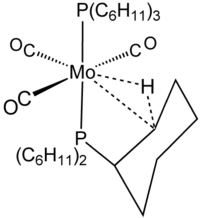Agostic interaction
In
History
The term agostic, derived from the
Short interactions between hydrocarbon substituents and coordinatively unsaturated metal complexes have been noted since the 1960s. For example, in tris(triphenylphosphine) ruthenium dichloride, a short interaction is observed between the ruthenium(II) center and a hydrogen atom on the ortho position of one of the nine phenyl rings.[4] Complexes of borohydride are described as using the three-center two-electron bonding model.

The nature of the interaction was foreshadowed in main group chemistry in the structural chemistry of trimethylaluminium.
Characteristics of agostic bonds
Agostic interactions are best demonstrated by
Strength of bond
On the basis of experimental and
Related bonding interactions
The term agostic is reserved to describe two-electron, three-center bonding interactions between carbon, hydrogen, and a metal. Two-electron three-center bonding is clearly implicated in the complexation of H2, e.g., in W(CO)3(PCy3)2H2, which is closely related to the agostic complex shown in the figure.[8] Silane
Anagostic bonds
Certain M┄H−C interactions are not classified as agostic but are described by the term anagostic. Anagostic interactions are more electrostatic in character. In terms of structures of anagostic interactions, the M┄H distances and M┄H−C angles fall into the ranges 2.3–2.9 Å and 110°–170°, respectively.[2][9]
Function
Agostic interactions serve a key function in alkene polymerization and stereochemistry, as well as migratory insertion.
References
- ^ ..
- PMID 17442749.

- .
- .
- .
- ISBN 9780120311538.
- ISBN 978-0-306-46465-2.
- .



